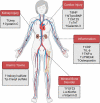Cardiomyopathy in chronic kidney disease: clinical features, biomarkers and the contribution of murine models in understanding pathophysiology
- PMID: 37915935
- PMCID: PMC10616472
- DOI: 10.1093/ckj/sfad085
Cardiomyopathy in chronic kidney disease: clinical features, biomarkers and the contribution of murine models in understanding pathophysiology
Abstract
The cardiorenal syndrome (CRS) is described as a multi-organ disease encompassing bidirectionally heart and kidney. In CRS type 4, chronic kidney disease (CKD) leads to cardiac injury. Different pathological mechanisms have been identified to contribute to the establishment of CKD-induced cardiomyopathy, including a neurohormonal dysregulation, disturbances in the mineral metabolism and an accumulation of uremic toxins, playing an important role in the development of inflammation and oxidative stress. Combined, this leads to cardiac dysfunction and cardiac pathophysiological and morphological changes, like left ventricular hypertrophy, myocardial fibrosis and cardiac electrical changes. Given that around 80% of dialysis patients suffer from uremic cardiomyopathy, the study of cardiac outcomes in CKD is clinically highly relevant. The present review summarizes clinical features and biomarkers of CKD-induced cardiomyopathy and discusses underlying pathophysiological mechanisms recently uncovered in the literature. It discloses how animal models have contributed to the understanding of pathological kidney-heart crosstalk, but also provides insights into the variability in observed effects of CKD on the heart in different CKD mouse models, covering both "single hit" as well as "multifactorial hit" models. Overall, this review aims to support research progress in the field of CKD-induced cardiomyopathy.
Keywords: animal; biomarker; cardiorenal; uremic cardiomyopathy.
© The Author(s) 2023. Published by Oxford University Press on behalf of the ERA.
Conflict of interest statement
The authors declare no conflict of interest.
Figures


References
-
- World Health Organization . Cardiovascular diseases [Internet]. 2021. Available from: https://www.who.int/health-topics/cardiovascular-diseases/#tab=tab_1 (27 October 2022, last date accessed).
-
- Eurostat . Eurostat: statistical office of the European Union (EU). Cardiovascular diseases statistics [Internet]. 2022; [cited 2023 Jan 26]. Available from: https://ec.europa.eu/eurostat/statistics-explained/index.php?title=Cardi... (27 October 2022, last date accessed).
Publication types
LinkOut - more resources
Full Text Sources

